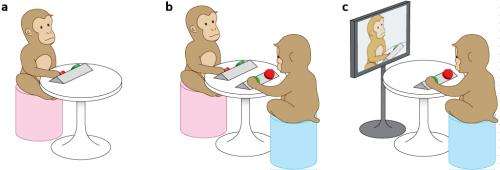New experimental method allows spontaneous synchronization of arm motions by pairs of Japanese macaques

Humans often synchronize their movements when, for example, we cooperate to move a piece of furniture. We also synchronize gestures and facial expressions when we interact. Coordinated actions are in fact surprisingly common in the animal kingdom, as exemplified by the flocking of birds and the schooling of fish. Such behaviors, however, have to date only been observed in the wild. Yasuo Nagasaka and colleagues from the Laboratory for Adaptive Intelligence at the RIKEN Brain Science Institute have now devised the first method for observing coordination under experimental conditions.
The researchers individually trained three Japanese macaque monkeys to press two buttons repeatedly and alternately with one hand. They then recorded the monkeys performing this task with a video camera and motion capture device.
Nagasaka and his colleagues later paired the monkeys and had them perform the task again while facing each other (Fig. 1). Initially, each monkey in a pair pressed the buttons at different speeds. However, after a certain amount of time, the two monkeys spontaneously synchronized their button presses by altering the speed of their actions so that their button presses became harmonized with those of their partner.
The speed of repeated button presses differed among the three pairs of monkeys, as did the timing of the synchrony. In one pair, the button presses were synchronized but one monkey was always delayed by 1 millisecond, while in another the delay was 13 milliseconds. In all cases, however, the timing of the actions became closely matched, and the delay seemed to be dependent on exactly which monkeys had been paired together.
The researchers then played back the video recordings of the monkeys performing the task at different speeds while a monkey watched. The monkeys sped up or slowed down their button presses to harmonize their actions with those of the 'virtual' monkey, and they seemed to prefer to slow down their button presses, perhaps to save energy.
In a final set of experiments, the research team allowed the real monkeys to either see or hear the video recordings, and found that visual information is far more important than auditory information for synchronization.
"We believe that this spontaneous synchronization plays an important role in the building of social bonds, and we are now looking for the brain areas responsible," says Nagasaka. "This could be fundamental to understanding the brain itself, and also the social interaction deficits in conditions such as autism."
A video showing the spontaneous synchronization of monkey actions can be found here.
More information: Nagasaka, Y. et al. Spontaneous synchronization of arm motion between Japanese macaques. Scientific Reports 3, 1151 (2013). dx.doi.org/10.1038/srep01151
















